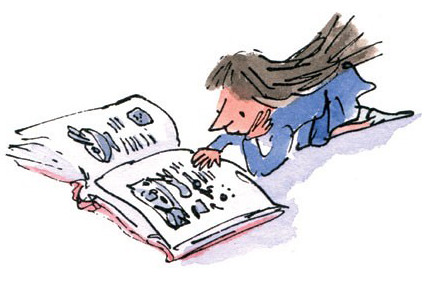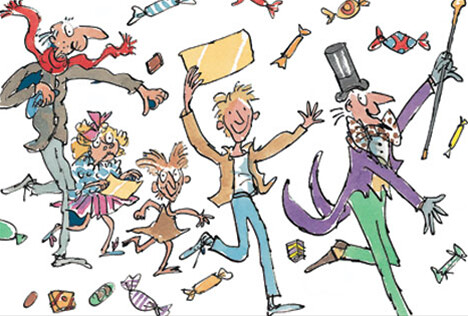 So far in this blog series we have examined the censorship of individual works; instead this post will focus on one author and the many books he published that faced criticism. Roald Dahl was a British novelist famous for his children’s stories. Dahl’s most famous works include Charlie and the Chocolate Factory, Matilda, and James and the Giant Peach. All three of these publications have been adapted to plays and have been major hits at the box office. Despite their fame, Dahl’s works have faced constant criticism from libraries, school boards, and radical religious groups.
So far in this blog series we have examined the censorship of individual works; instead this post will focus on one author and the many books he published that faced criticism. Roald Dahl was a British novelist famous for his children’s stories. Dahl’s most famous works include Charlie and the Chocolate Factory, Matilda, and James and the Giant Peach. All three of these publications have been adapted to plays and have been major hits at the box office. Despite their fame, Dahl’s works have faced constant criticism from libraries, school boards, and radical religious groups.
 Evil adult characters are common throughout Dahl’s narratives. This theme is most apparent in Matilda. In the novel Matilda is abused by her parents and Miss Trunchball, the school principle. Through independent learning and self-motivation Matilda learns magical skills to fight back against those who wish to bring her down. Some might view Matilda’s story as a lesson in personal triumph and an example of the eternal fight for good against evil. However, library and school administrators have pushed for the censorship of the book on the grounds that the presentation of neglectful abusive parents can be harmful to young children. And the idea that children should not use tricks for personal gain. Many parents have distaste for the story because it exalts the genius child over the irrational and idiotic parents. This criticism is common of any children’s story that promotes childhood independence. Luckily for Dahl, although Matilda has been criticized and avoided by parents, the book has never been officially banned or listed on the American Library Association’s banned books list. Unfortunately, that cannot be said for the other two of Dahl’s most famous children’s stories.
Evil adult characters are common throughout Dahl’s narratives. This theme is most apparent in Matilda. In the novel Matilda is abused by her parents and Miss Trunchball, the school principle. Through independent learning and self-motivation Matilda learns magical skills to fight back against those who wish to bring her down. Some might view Matilda’s story as a lesson in personal triumph and an example of the eternal fight for good against evil. However, library and school administrators have pushed for the censorship of the book on the grounds that the presentation of neglectful abusive parents can be harmful to young children. And the idea that children should not use tricks for personal gain. Many parents have distaste for the story because it exalts the genius child over the irrational and idiotic parents. This criticism is common of any children’s story that promotes childhood independence. Luckily for Dahl, although Matilda has been criticized and avoided by parents, the book has never been officially banned or listed on the American Library Association’s banned books list. Unfortunately, that cannot be said for the other two of Dahl’s most famous children’s stories.
 James and the Giant Peach is a children’s adventure story where an abused young boy magically travels with a group of talking insects inside a giant peach to New York City. Like Matilda, James is characterized as a smart, independent, good boy. Also like Matilda, James is abused by his aunts Spike and Sponge, who serve as his legal guardians, after his parents are tragically killed by a Rhinoceros. The narrative is resolved with James and his arthropod friends successfully landing in the big apple where the peach pit is turned into a house located in Central Park. James and the Giant Peach has been censored many times since its publication in 1961. “It has been banned for being too scary for the targeted age groups, mysticism, sexual inferences, profanity, racism, references to tobacco and alcohol, and claims that it promotes disobedience, drugs, and communism” (bannedbooksweeks.com). In the early 1990s a public school system In Texas banned James and the Giant Peach from the primary school classrooms, library, and syllabi because the school district’s superintendent argued that the books were inappropriate for young children based off the use of curse words in the book such as “ass”. In 1986 a small Wisconsin town banned the book because of a scene featuring the spider licking her lips. Religious groups in the town argued that this scene could be “taken in two ways, including sexual” (The Times of London). A year after this incident, a woman in Hernando County Florida took issue with the Grasshopper’s statement, “I’d rather be fried alive and eaten by a Mexican”, arguing that the book promoted racist ideals. This woman also was bothered by the books depiction of snuff, tobacco, and whiskey. Her complaints to the local school districts led to a review by the Florida school board ending in the book being temporarily banned from the schools reading list.
James and the Giant Peach is a children’s adventure story where an abused young boy magically travels with a group of talking insects inside a giant peach to New York City. Like Matilda, James is characterized as a smart, independent, good boy. Also like Matilda, James is abused by his aunts Spike and Sponge, who serve as his legal guardians, after his parents are tragically killed by a Rhinoceros. The narrative is resolved with James and his arthropod friends successfully landing in the big apple where the peach pit is turned into a house located in Central Park. James and the Giant Peach has been censored many times since its publication in 1961. “It has been banned for being too scary for the targeted age groups, mysticism, sexual inferences, profanity, racism, references to tobacco and alcohol, and claims that it promotes disobedience, drugs, and communism” (bannedbooksweeks.com). In the early 1990s a public school system In Texas banned James and the Giant Peach from the primary school classrooms, library, and syllabi because the school district’s superintendent argued that the books were inappropriate for young children based off the use of curse words in the book such as “ass”. In 1986 a small Wisconsin town banned the book because of a scene featuring the spider licking her lips. Religious groups in the town argued that this scene could be “taken in two ways, including sexual” (The Times of London). A year after this incident, a woman in Hernando County Florida took issue with the Grasshopper’s statement, “I’d rather be fried alive and eaten by a Mexican”, arguing that the book promoted racist ideals. This woman also was bothered by the books depiction of snuff, tobacco, and whiskey. Her complaints to the local school districts led to a review by the Florida school board ending in the book being temporarily banned from the schools reading list.
 Like James and the Giant Peach, the world famous children’s tale Charlie and the Chocolate Factory has faced multiple challenges since its publication in 1964. This classic was originally challenged for its depictions of the Oompa Loompas, arguing that citing the characters as small black pygmies was racist. To curb this attack Dahl changed the description of the Oompa Loompas in the revised edition, published in 1988. In this second edition Dahl describes the intriguing factory workers as “knee-high dwarves with rosy white skin and funny long golden-brown hair who came from Loompaland”. This description avoids accusations of racism by depicting them as obviously white. However Dahl’s edits did not appease all critics. In 1990 one Colorado librarian appealed to the American Library Association to censor Dahl’s story. She argued that the book promoted a poor philosophy on life and that Charlie, the main character, had no redeeming positive traits, only the absence of negative ones.
Like James and the Giant Peach, the world famous children’s tale Charlie and the Chocolate Factory has faced multiple challenges since its publication in 1964. This classic was originally challenged for its depictions of the Oompa Loompas, arguing that citing the characters as small black pygmies was racist. To curb this attack Dahl changed the description of the Oompa Loompas in the revised edition, published in 1988. In this second edition Dahl describes the intriguing factory workers as “knee-high dwarves with rosy white skin and funny long golden-brown hair who came from Loompaland”. This description avoids accusations of racism by depicting them as obviously white. However Dahl’s edits did not appease all critics. In 1990 one Colorado librarian appealed to the American Library Association to censor Dahl’s story. She argued that the book promoted a poor philosophy on life and that Charlie, the main character, had no redeeming positive traits, only the absence of negative ones.

To see our exhibit featuring the works of Roald Dahl please visit the Department of Special Collections located on the 5th floor of McFarlin library. We are open to the public Monday-Friday 8-5.
Also, be sure to check back next week to discover why some of our favorite young adult novels have faced criticisms, censorship, and banning in the final post in this series on banned children’s books.
